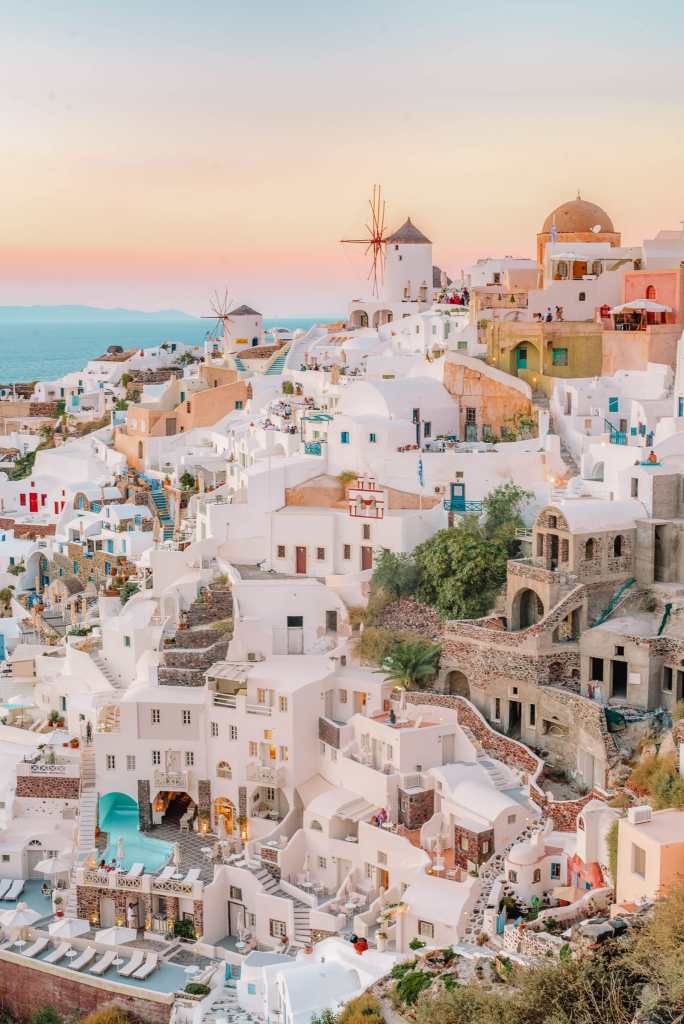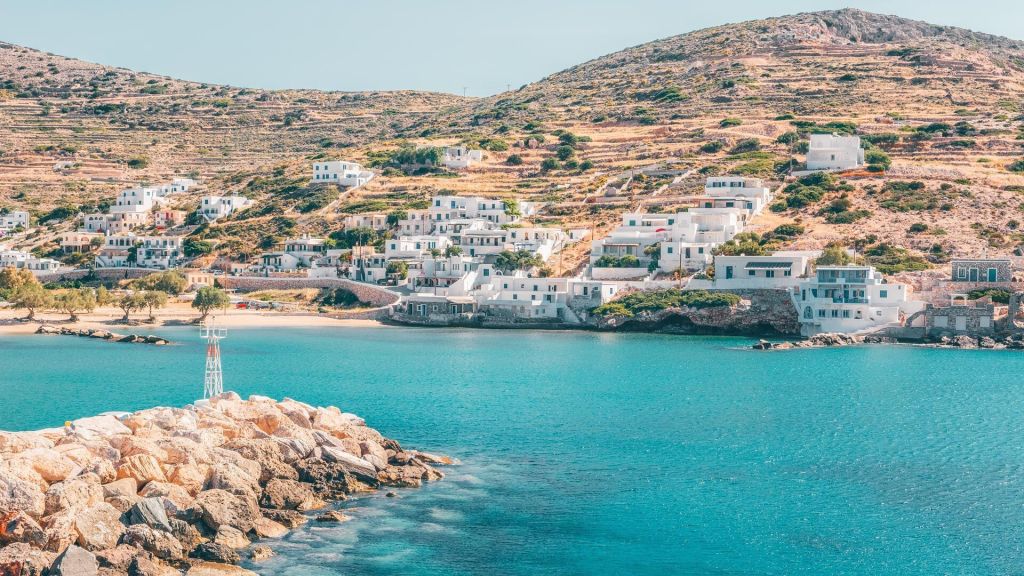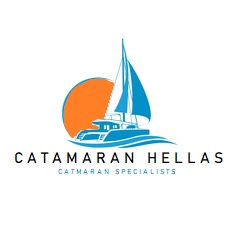THE CYCLADES ISLANDS

KEA
Kea is the closest of the Cyclades to the mainland, it has a shoreline of 81km. While it appears barren from a distance, the bare hills hide fertile valleys filled with orchards and olive groves. The main settlements are the port of Korissia, set on a large bay with a sandy beach and the capital, Ioulida, which is a pleasant hillside town, full of alleyways and winding steps. Around Kea, the island’s best beach Pisses is a long sandy cove backed by a green valley of orchards and olive groves. Koundouros, lies on a bay of crystal clear water, while the sandy beach at Poles sits on the ancient site of Karthea on the southeastern side of the island. Vourkari, a popular stop for yachts, is a trendy resort filled with lovely shops. Otzias is a picturesque village enclosed in a cove.

KYTHNOS
52 nautical miles from Piraeus
Kythnos is extremely popular with Athenian holidaymakers. The villages, Hora and Dryopida are typically Cycladic with their winding streets and windmills. There are a number of pretty little bays all along the coastline. On the northeastern side of the island lies Loutra, a popular summer spot renowned for its thermal springs. The best beaches are on the southeastern coast, near the village of Kanala. Below the monastery Panagia Knanlia There are also several sandy beaches located north and south of Merihas, such as Episkopi and Apokrousi and Flambouria.

SERIFOS
70 nautical miles from Piraeus
From afar, the island of Serifos appears like a great rock rising out of the sea. Clinging on the hillside above the main port, Livadi, is the dazzling whitewashed capital Hora, it is one of the most striking Cycladic capitals. There are several good beaches to visit, such as the tamarisk-fringed beach at Livadakia, Karavi, which is the unofficial nudist beach and Lia. Psili Ammos and the sheltered bay of Agios Sostis, are also good choices. Norheast of the island is uninhabited islet of Serfopoula.

SIFNOS
78 nautical miles from Piraeus
At first glance it looks deceptively barren, but once you explore, you’ll find an abundantly attractive and fertile landscape, Sifniot olive oil is one of the best in Greece. Local specialties include revithia (baked chickpeas), revithokeftedes (vegetable balls), xynomyzithra (a sharpish cheese) and almond sweets. As well as shopping for fine ceramics and jewellery, you can also find beautiful hand-woven textiles. The capital, Apollonia, is a lovely whitewashed village set on a plateau 5km up from the port of Kamares. 3km from Apollonia is the walled cliff-top village of Kastro, it is a magical place of buttressed alleys and whitewashed houses. Around Sifnos The resort of Platys Gialos has a long sandy beach, nearby is the spectacularly situated Moni Hrysopigilis. A path from the monastery leads to a beach with a taverna. Vathi, on the west coast, is a gorgeous sandy bay. Faros is a cozy little fishing hamlet with a couple of nice beaches.

MILOS
78 nautical miles from Piraeus
Volcanic Milos is the most westerly island of the Cyclades. It has a coastline of 125km. Klima is a charming, unspoilt fishing village skirting a narrow beach below the settlement of Trypiti. Nearby you will discover Greece’s only Christian catacombs. A sail around the island allows you to visit most of Milos’ stunning beaches (many inaccessible by road), coves and geologically interesting places. There are also a number of sea caves, such as Papafranga and Sykia. Northwest of Milos is the uninhabited islet of Antimilo. Upon entering Milos bay you can’t miss the impressive rocky islets of Akradies.

KIMOLOS
This small island lies just half a mile northeast of Milos. In spite of the close proximity, it does not attract many tourists. From the port of Psathi you can sail to Kafto Beach to visit the underwater ruins of the ancient city. In the center of the island is the 364m-high cliff on which sits the fortress of Paleokastro.

ANDROS
89 nautical miles from Piraeus
Andros is the northernmost island of the Cyclades. It is the second largest after Naxos with a coastline of 177km. It is also one of the most fertile and forested islands in the Cyclades.There is an abundance of water, Andros is renowned for its water, which is bottled at Sariza. Many of the old windmills are now being restored. Set dramatically along a narrow peninsula on the east coast lies enchanting Hora. It has two outstanding museums, the archaeological and the museum of modern art. There is also a nautical museum. On the west coast between the main port, Gavrio and Paleopolis Bay are several nice beaches: Agios Kyprianos (where a former church is now a beach front taverna), Delavoia (nudist), Green Beach and Anerousa. If you sail around the island there is Nimborio, Gialia, and Paraporti Beach, which are near Hora. The pretty emerald bay and holiday hamlet at Ormos Korthiou, in the southeast, has a lot of old charm. Near Sineti, the wild Dipotamata Gorge and its water mills are now EU protected. One of the most beautiful isolated spots Andros is Pidima tis Grias bay.

TINOS
86 nautical miles from Piraeus
Tinos is green and mountainous like nearby Andros with a coastline of 106km. The island is a Greek Orthodox place of pilgrimage. Dominating over the capital, Hora, is the celebrated Church of Panagia Evangelistra, while unspoilt hill villages and ornate dovecotes are rural attractions. Pyrgos is a picturesque village where marble is still carved. There is a sculpture school and several workshops where traditional items such as lintels and plaques can be purchased. The island has a number of beautiful beaches to visit such as Porto (6km east of Hora) and Kolymvythra Bay, which has two superb sandy beaches.

MYKONOS
94 nautical miles from Piraeus
Mykonos is perhaps the most visited of all Greek islands. It has by far the most sophisticated and exciting nightlife in Greece. Whitewashed Hora, the islands main port is a labyrinth of winding cobbled stoned alleys. Despite the throngs of people, it is most beautiful. The waterfront is filled with colorful fishing boats (caiques), and windmills spot the surrounding hilltops. There are five museums to visit: the archaeological, the folklore, the Aegean Maritime, the windmill, and Lena’s house (19th century Mykonian house with furnishings). The Panagia Paraportiani is the most famous of Mykonos’ several hundred churches. It is actually four little churches united into one beautiful white, knobby, asymmetrical structure. It is a photographer’s dream Beaches To the south beyond Ornos, is Agios Ioannis and to the east is Psarou, a lovely little cove. The islands best beaches are further around the south coast: Paradise, Super Paradise, Agrari and Elia. Nudism is accepted on all these beaches. Elia is the least crowded. North coast beaches are exposed to the meltemi winds, but Panormos and Agios Sostis are sheltered and uncrowded. Dragonisi is an uninhabited islet east of Mykonos.

DELOS
Lying a few kilometers off the west coast of Mykonos is Delos, one of the most important archaeological sites in Greece. This sacred, barren island is the mythical birthplace of Apollo and Artemis. In the 8th century BC, a festival in honor of Apollo was established; the oldest temples and shrines date from this era. But Delos did not reach the height of its power until the Hellenistic period, becoming one of the three most important religious and commercial centers in Greece. It was populated with wealthy merchants, mariners and bankers from as far away as Egypt and Syria. Although Apollo was the principle deity these inhabitants erected temples to the various gods revered in their native lands.

SYROS
83 nautical miles from Piraeus
The capital of Syros is Ermoupolis, an affluent, lively town of elegant neoclassical mansions, squares, marble paved streets and chic boutiques. As your boat sails into the harbor you will catch a glimpse of the Catholic settlement of Ano Syros to the left, and the Orthodox settlement of Vrodado to the right, both situated on hills with Ermoupolis spilling down to the harbor, it is an impressive sight. Ano Syros is a medieval settlement with narrow alleyways and whitewashed houses. It is a fascinating place to visit.

PAROS
95 nautical miles from Piraeus
Paros is an attractive island of terraced hills, whitewashed settlements and windmills. It is the center of the Cyclades. The island’s busy capital and port is Parikia, a charming, typically Cycladic old town with a 13th century Venetian kastro. The Pangia Ekatontapyliani church, which dates from 326 AD is one of the most splendid in the Cyclades. Naoussa, on the north coast is a popular resort at the heart of which is a colorful fishing village. Although it has an up market feel to it Naoussa is still a working harbor with piles of fishing nets, bright caiques, and little ouzeria. It is a relaxed, picturesque village with whitewashed alleyways. There are a number a good beaches close-by, the best are Kolimvythres, Monastiri, and Santa Maria. Lefkes, 12km southeast of Parikia, is the island’s highest and loveliest village. In July and August Petaloudes is almost enshrouded in butterflies, the sight is spectacular. Other beaches worth visiting are Piso Livadi, Krios and Hrysi Akti. Opposite from Dryos is the tiny islet Dryonis, which is fantastic for fishing.
ANTIPAROS
This small islands lies off the southwest coast of Paros, it has a coastline of 56 km. The main village, Antiparos is an attractive and charming port. The Cave of Antiparos is an awe-inspiring site. At the entrance is a small chapel dedicated to St John from here the steps descend deep into the stalactite and stalagmite filled cave. There are a number of good beaches to visit: Psaslyki, Sifnakos Gialos, Agios Gialos and Strongyle. The small islets, which surround the Antiparos have formed narrow straits between them.

NAXOS
103 nautical miles from Piraeus
Naxos is the largest of the Cyclades. Its rugged mountains and fertile green valleys also make it one of the most beautiful. Mt Zeus (1004m) is the archipelago’s highest peak. It was a prominent Byzantine center with over 500 churches and monasteries. Hora is the island’s capital and port. The most alluring part of Hora is Kastro, with its winding alleyways and whitewashed houses. There are also some handsome Venetian dwellings. It has a medieval atmosphere. A causeway to the north of the port leads to the islet of Palatia and the unfinished Temple of Apollo. The lovely Tragaea region is a vast plain of olive groves and unspoilt villages harboring numerous little Byzantine churches.

IOS
107 nautical miles from Piraeus
There is no denying that most visitors flock to Ios to party hard, but for those seeking relaxation, Ios has plenty to offer amongst its beautiful beaches and charming capital, Hora. Hora is a lovely Cycladic village with narrow whitewashed laneways and houses. At night the tiny central square is transformed into a crowded open-air party. Apart from the nightlife, the beaches are what lure travelers to Ios. Competing with Milopotas for the best beach is Manganari, which has a long swathe of fine white sand. Nearby, Kolitzani Beach and Tsamaria are also nice. Agio Theodoti, Psathi and Kalamos beaches, all on the northeast coast, are more remote.

SANTORINI (THIRA)
130 nautical miles from Piraeus
Santorini, the southern most island of the Cyclades, is thought of by many as the most spectacular of the Greek islands. The submerged caldera (crater) is a vestige of what was most likely one of the most catastrophic volcanic eruptions in recorded history. Tourism has not diminished the dramatic atmosphere of Fira. Terraced into the volcanic cliffs are barrel-roofed cave houses and domed churches. Along the lip of the caldera are several bars and restaurants, the view of the cliffs and their multicolored layers of lava and pumice, from here is breathtaking. Ships berth at Athinios, a tiny haven beneath the towering volcanic cliffs. In favorable weather, ships anchor offshore below Fira, whose dazzling white houses and domes extend along the cliff top nearly 210m above. Further north, the village of Oia is also set on the steep slope of the caldera, many of its whitewashed buildings nestle in recesses in the volcanic rock. It is famous for its spectacular sunsets. The tiny port, Ammoudi lays 300 steps below Oia, it’s a lovely spot for a swim and a bite to eat. There are five commercial wineries to visit, they host tastings in the summer. The potent Santorini wine has a great reputation. Ancient Akrotiri was a Minoan settlement, with buildings dating to the 16th century BC. Excavations started in 1967, have unearthed an ancient city beneath the volcanic ash. The site is defiantly worth a visit. Beaches Santorini’s black sand beaches are beautiful but very hot. The nicest beaches are on the east coast, such as Perivolos, Perissa and Agios Georgios. The Mediterranean Dive Club in Perissa, offers volcanic and wreck dives. There is also Kamari, Monolithos Beach and Red Beach.

THIRASIA & VOLCANIC ISLETS
Charming Thirasia was separated from Santorini by an eruption in236 BC. The hora, Manolas, is a lovely, unspoilt village perched on the cliff. To reach it, one must climb the 145 steps from the harbor. The volcanic islets of Palia Kameni and Naea Kameni are still active, they are good for a day excursion.

ANAFI
12 nautical miles from Santorini
Small, charming Anafi is where you go to enjoy the beaches and the slow paced traditional life. It’s an ideal place to relax. The main town, Hora lies 2km up from the island’s little port Agios Nikolas. Whitewashed dwellings and windmills nestle against the hillside. There are several lovely beaches to visit, such as palm lined Klissidi. Islets around Anafi are: Pacheia, Marra and Anydros

SIKINOS
113 nautical miles from Piraeus
The only settlements in tranquil Sikinos are the port of Alpronia and the hilltop villages Hora and Kastro, which together form the capital. Kastro is a charming, little village with lovely old homes and hospitable locals. Many of the beaches are only accessible by boat, such as Agios Georgios, Malta (with ancient ruins on the hill above), Karra. Katergo and Agios Nikolaos Beach are in walking distance to Alopronia.

FOLEGANDROS
106 nautical miles from Piraeus
Most visitors come to peaceful Folegandros for the unspoilt island life. Boats dock in the small harbor of Karavostasis on the east coast. Hora, the hidden cliff top village is perhaps the most beautiful capital in the Cyclades. The medieval kastro and the maze of narrow whitewashed streets and low archways date back to the 13th century. Bougainvillea cascade down the house’s wooden balconies. There are several good beaches to visit such as Agnali Beach, Agios Nikolaos, Livadaki and Agios Georgios.
